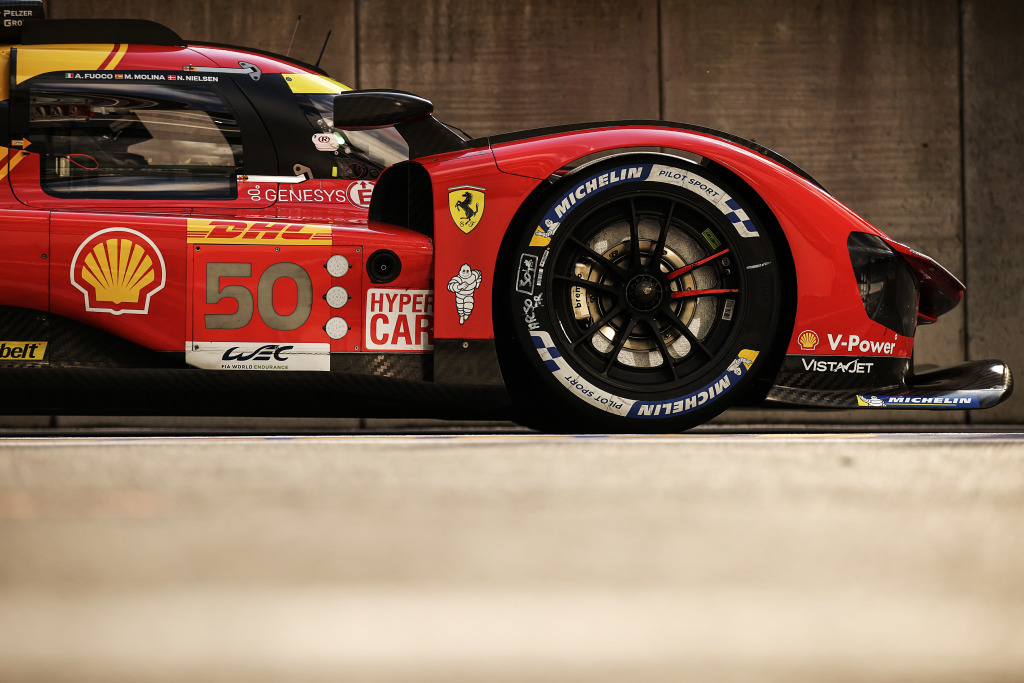Ferrari Attiva Sportive GT boss Antonello Coletta and Giuliano Salvi, the Ferrari GT & Sports Race Cars race and testing manager, have both spoken out on the FIA World Endurance Championship’s decision to ban tire warmers for this season, following the incident-packed race week at Spa.
The rule change, which was made to reduce the environmental impact the FIA WEC has during race meetings, has been a key topic of discussion since the first round of the season. However, throughout the meeting Spa, which was held in significantly colder temperatures than the events in Sebring and Portimao, the debate came more into focus as teams and drivers began to question whether or not it is a safety issue that needs further thought.
The track action in Belgium was heavily impacted by multiple incidents throughout the meeting, caused specifically by drivers struggling to heat up their stone-cold tires. This included two accidents for front-running Hypercar factory drivers, Toyota’s Brendon Hartley and Ferrari’s Antonio Fuoco, both of whom were passengers in their respective cars as they veered off the notoriously unforgiving Spa circuit.
For Hartley, the off at Raidillon in qualifying meant he and his teammates in the No. 8 GR010 HYBRID were forced to start at the very back of the grid. Not only did the team have to deal with the consequences of not setting a time, it further disrupted the team’s race strategy as it also lost a set of tyres that were needed for the race.
A day later, Fuoco’s accident in the No. 50 Ferrari 499P during the race was more damaging still. The Italian, driving in a straight line out of the pits, was sent careening into the guardrail on the run down to Eau Rouge after the car snapped sideways. The retirement for the No. 50 came after an earlier moment at in the race, when Miguel Molina suffered major understeer at pit out, narrowly avoiding the concrete divider between the pit lane and the exit of La Source. Thankfully the Spaniard missed it, but he was later penalised for crossing the pit exit white line.
“This (Fuoco’s) kind of incident comes from regulations without blankets. We saw the same with Toyota. We saw a lot of crashes. We said many times Spa could be tricky, but it’s the same for everybody. Fortunately, nobody was injured,” Salvi told the media in a post-race technical briefing.
[lawrence-auto-related count=3 category=1416]
Coletta expanded on Salvi’s thoughts later in the evening with a post-race statement which was openly critical of the new regulation, describing it as “dangerous.”
“Starting from the assumption that the rules are the same for everyone and that we abide by them, I think we need to reflect on the ban on tire warmers,” he said. “It’s a common opinion in the paddock and among professionals, not to mention the drivers, that this situation has become dangerous. At Spa, there have been many accidents and extreme episodes due to cold temperatures and changeable weather, and it’s time to do some serious thinking on the matter because it has major ramifications for safety.
“We are on the eve of a decisive race like the 24 Hours of Le Mans where, overnight, temperatures are low and speeds very high. It’s not just an issue for us. The accidents involved different cars, from different classes, driven at the time by both professional and gentleman drivers, and this situation had already been predicted some time ago.”

It’s not just members of the Ferrari team that have been vocal on this issue since yesterday’s race. Toyota driver Mike Conway, who went on to win the 6 Hours of Spa in the No. 7 GR010 HYBRID, told RACER he would welcome the return of tire warmers.
“Yeah,” he said when asked directly if it was time for a change. “There are some people pushing for it. We saw Brendon yesterday in qualifying. When you leave the pits you are on ice and (just) surviving.”
However, Conway questions whether such a change in regulations would be smart, or even feasible ahead of Le Mans, which is just weeks away.
“I wouldn’t be against it, but I don’t know if they can do such a big change going into Le Mans,” he continued. “Does everyone have the capacity to do it?
“We also don’t know what effect it will have on the tires by warming them a bit quicker. Maybe something could be done? It could avoid these incidents. In colder temperatures, on a high-energy track like here, you’re forced into a situation where you have got to take a tire that’s a bit harder and harder to warm up.
“Yes,” he said when asked by RACER if he was worried about Le Mans. “Not so much at the exit of pit lane, but when you come down that hill (after the Dunlop Bridge), I know already what it’s going to feel like.”
While rule makers have repeatedly stated that there is no intention to change or even review this new policy, on-track incidents and now public reaction from key partners in the championship inevitably add pressure to look again at the initial problem, the chosen solution, and any available alternatives.
